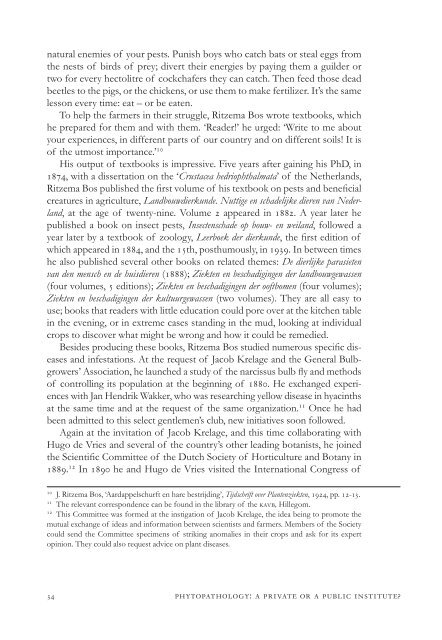PDF (full volume) - DWC - KNAW
PDF (full volume) - DWC - KNAW
PDF (full volume) - DWC - KNAW
You also want an ePaper? Increase the reach of your titles
YUMPU automatically turns print PDFs into web optimized ePapers that Google loves.
natural enemies of your pests. Punish boys who catch bats or steal eggs from<br />
the nests of birds of prey; divert their energies by paying them a guilder or<br />
two for every hectolitre of cockchafers they can catch. Then feed those dead<br />
beetles to the pigs, or the chickens, or use them to make fertilizer. It’s the same<br />
lesson every time: eat – or be eaten.<br />
To help the farmers in their struggle, Ritzema Bos wrote textbooks, which<br />
he prepared for them and with them. ‘Reader!’ he urged: ‘Write to me about<br />
your experiences, in different parts of our country and on different soils! It is<br />
of the utmost importance.’ 10<br />
His output of textbooks is impressive. Five years after gaining his PhD, in<br />
1874, with a dissertation on the ‘Crustacea hedriophthalmata’ of the Netherlands,<br />
Ritzema Bos published the fi rst <strong>volume</strong> of his textbook on pests and benefi cial<br />
creatures in agriculture, Landbouwdierkunde. Nuttige en schadelijke dieren van Nederland,<br />
at the age of twenty-nine. Volume 2 appeared in 1882. A year later he<br />
published a book on insect pests, Insectenschade op bouw- en weiland, followed a<br />
year later by a textbook of zoology, Leerboek der dierkunde, the fi rst edition of<br />
which appeared in 1884, and the 15th, posthumously, in 1939. In between times<br />
he also published several other books on related themes: De dierlijke parasieten<br />
van den mensch en de huisdieren (1888); Ziekten en beschadigingen der landbouwgewassen<br />
(four <strong>volume</strong>s, 5 editions); Ziekten en beschadigingen der ooftbomen (four <strong>volume</strong>s);<br />
Ziekten en beschadigingen der kultuurgewassen (two <strong>volume</strong>s). They are all easy to<br />
use; books that readers with little education could pore over at the kitchen table<br />
in the evening, or in extreme cases standing in the mud, looking at individual<br />
crops to discover what might be wrong and how it could be remedied.<br />
Besides producing these books, Ritzema Bos studied numerous specifi c diseases<br />
and infestations. At the request of Jacob Krelage and the General Bulbgrowers’<br />
Association, he launched a study of the narcissus bulb fl y and methods<br />
of controlling its population at the beginning of 1880. He exchanged experiences<br />
with Jan Hendrik Wakker, who was researching yellow disease in hyacinths<br />
at the same time and at the request of the same organization. 11 Once he had<br />
been admitted to this select gentlemen’s club, new initiatives soon followed.<br />
Again at the invitation of Jacob Krelage, and this time collaborating with<br />
Hugo de Vries and several of the country’s other leading botanists, he joined<br />
the Scientifi c Committee of the Dutch Society of Horticulture and Botany in<br />
1889. 12 In 1890 he and Hugo de Vries visited the International Congress of<br />
10 J. Ritzema Bos, ‘Aardappelschurft en hare bestrijding’, Tijdschrift over Plantenziekten, 1924, pp. 12-13.<br />
11 The relevant correspondence can be found in the library of the kavb, Hillegom.<br />
12 This Committee was formed at the instigation of Jacob Krelage, the idea being to promote the<br />
mutual exchange of ideas and information between scientists and farmers. Members of the Society<br />
could send the Committee specimens of striking anomalies in their crops and ask for its expert<br />
opinion. They could also request advice on plant diseases.<br />
34 phytopathology: a private or a public institute?

















